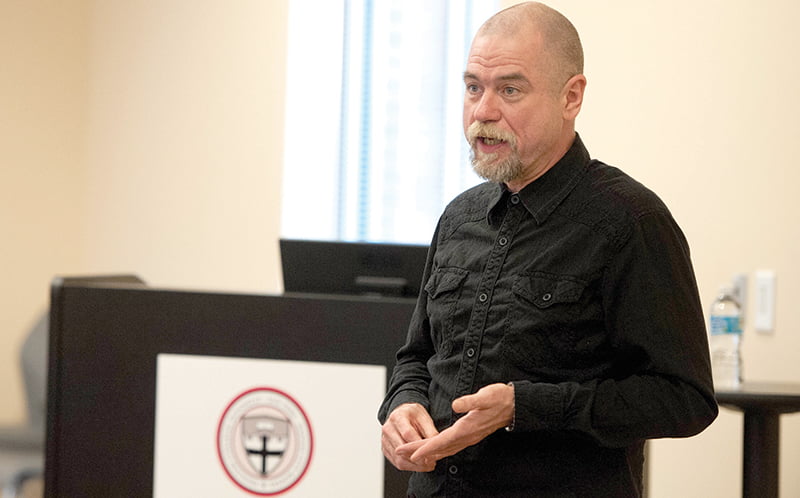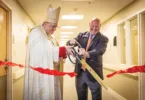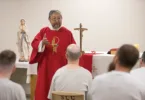 by Jessica Langdon
by Jessica Langdon
jessica.langdon@theleaven.org
KANSAS CITY, Kan. — Curtis McCarty was embarrassed to stand before a crowd and bare his soul. But when he finished sharing his life story at Donnelly College here, he received a standing ovation.
McCarty spent 21 years in prison — 19 on death row — for a murder that DNA and other evidence have now shown he didn’t commit.
The exonerated McCarty now speaks against the death penalty, which is legal in Kansas.
McCarty’s story puts a face on the issue, said Bill Scholl, archdiocesan consultant for the office of social justice, to the crowd gathered April 8 at the college’s Community Event Center.
“At the end of the day, the last thing that we should ever want to do is to send an innocent man to his death,” said Mike Fonkert, Kansas City-area coordinator for the Kansas Coalition Against the Death Penalty.
McCarty described his childhood as a good one, during which he excelled in school. But when he was 15, he started using drugs and spiraled into addiction. By 16, he had quit school and turned away from family and community.
And it was that life — one he promised he would turn away from every time he found himself handcuffed in the back of a police car — that led him to meet a young woman named Pamela Willis.
In Oklahoma City in December 1982, “a man broke into her house, attacked her, and killed her,” he said.
People who knew the 18-year-old Willis were stunned.
“We couldn’t make sense of it, and it turns out the police couldn’t make sense of it, either,” said McCarty.
As one of more than 40 male acquaintances identified, McCarty voluntarily answered questions and submitted blood, saliva and fingerprints — and resumed his life of addiction.
Then in 1985, McCarty found himself again facing questions in the murder case, when someone told law enforcement he might know who had done it.
After days of questioning, he was charged.
At first, he assumed truth would prevail, trusting in the system he had long ago learned about in school.
“Unfortunately, everything that could go wrong, did go wrong,” he said.
Life on death row
A few days into his trial, McCarty said, he knew he was going to prison. It was then that a forensic analyst testified that biological evidence collected at the scene was consistent with McCarty — a change from her initial findings, says the Innocence Project, which is dedicated to helping prisoners prove innocence through DNA.
He was found guilty and, during sentencing, “I was confronted with the evidence of how badly I had damaged my reputation,” he said. Only his parents testified on his behalf, begging that his life be spared.
But he was sentenced to death.
A few years later, when findings of misconduct by the prosecutor and circumstances related to the forensic analyst resulted in a new trial, said McCarty, he was again convicted, and again sentenced to death.
A third sentencing trial later resulted in a third death sentence.
Housed with other death row inmates, McCarty discovered that many were poor and poorly educated; others suffered from mental illness. Some had committed “atrocities,” he said. But others had been convicted for being accomplices in a crime in which people had died, even if they themselves had not committed the act.
He watched his fellow prisoners grow from basically kids into men who came to understand their actions and the impact they had had.
He has had friends be executed. One with whom he shared a “cage” used to stay up talking about personal responsibility and justice and what can be done about the hurt they caused — issues that didn’t readily offer answers.
“It was the hardest thing that I did in my entire life when his time came and they came for him and said, ‘Let’s go,’” said McCarty. “I helped him pack up his stuff, and they let him walk down to the sally port with me to say goodbye to him.”
He began to resign himself to his own death.
Choosing life
But then, finally, came a break. A number of cases handled by the same forensic analyst were revisited for possibly false forensic results.
In McCarty’s situation, hair evidence sought for re-examination on appeal turned up missing, never to be found, reported the Innocence Project.
After 21 years, McCarty was released from prison in 2007.
By then, adjusting to life outside wasn’t easy.
Inspired by the Community of Sant’Egidio, a Catholic group based in Rome, McCarty started to consider in what way he could aid them in their efforts to bring an end to the death penalty.
The community encouraged him to look beyond the personal embarrassment he felt at having been incarcerated, and focus instead on the contribution he could make.
Sant’Egidio, said McCarty, has taught him this: “Participate in your community, and do so positively, and become a force not in your own lives but in the lives of others, and make a difference.”
Working for abolition
The presentation encouraged McCarty’s listeners to make a difference, as well, by letting their state representatives and senators hear their voice.
“When we have someone like Curtis come and speak, he puts a power to his message that — having never lived it — I can’t put . . . there,” said Fonkert. “But you can feel it in his voice and you can see it in his eyes, and it makes the experience different for people.”
“There’s a strong fight to oppose the death penalty, and leading the fight are the Kansas bishops, because the Catholic Church believes in the dignity of the human person,” Scholl told attendees.
A bill in the House and another in the Senate aiming to end the death penalty in Kansas weren’t expected to go anywhere this year. The House bill was never heard, but a January hearing for the Senate bill, which never advanced, showed strong support for its abolition, said Fonkert.






